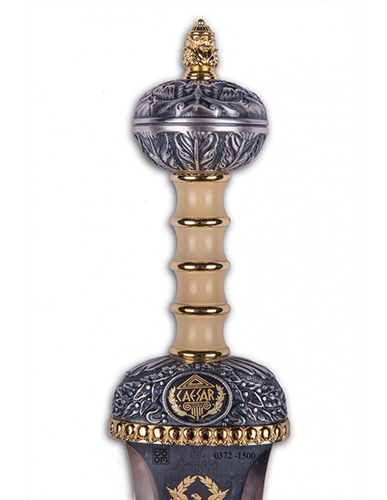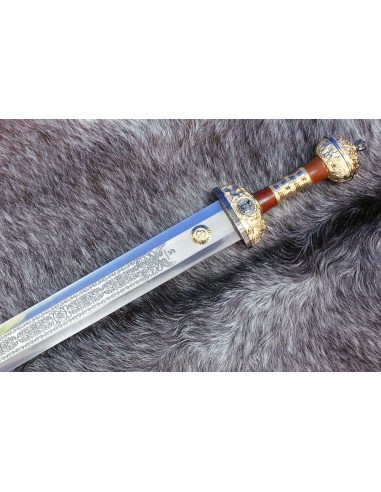THE STORY OF THE ROMAN GLADIUS
The gladius sword was the weapon of the Roman soldiers. With it Rome took practically all the known towns then. Its simplicity, together with the organization of the Roman cohorts and legions, made it a deadly weapon. The gladius sword together with the scutum (shield), constitute a symbol of the powerful power that was Rome from the military point of view. This set of Roman gladius and scutum was greatly feared by its enemies. Fear comparable to that of the Romans themselves when they faced the Celtiberians, from whom they copied and adopted the gladius . Tito Livio confirms this point in his writings. The fame of the sword as a fearsome weapon was based on the way of fighting of the Romans, which was characterized by being very organized, forming lines of soldiers who protected each other behind their rectangular shields. The gladius was a sword to be used in a group, by an ordered troop and submitted to the orders of their bosses. Through swift and rapid assault they achieved a devastating effect on their enemies. Much of their effectiveness was due to compliance with the orders received from their bosses and ordering of the legions. But when the prime of Rome passed, the gladius was displaced by the spatha . So the Roman legions, at this time when the empire was breaking down, the gladius lost effectiveness because the legionnaires did not have the submission and discipline that they had in the early days of the Empire.
The Romans were not the creators of the gladius , but rather adopted it from other peoples in the 3rd century BC. C., in the middle of the Second Punic War, when the Spanish mercenaries, who used this weapon, caused heavy losses in the Roman army. It was a remarkable weapon, especially when used in conjunction with rectangular shields, and was uniquely suited to the Roman way of fighting. It was an excellent cutting weapon due to the fact that it had a double edge.
There were many variations of the gladius sword , but we are going to focus on 4 of them, which we consider to be the best known. It is necessary to say that one variation displaced another, but that all were used together except the following variation:
1.-Gladius Hispaniensis , adopted from the Celtiberians. It was used between 216 BC and 20 BC Sheet 60/68 cm. Chest length 75/85 cm. Width 5 cm. Weight 900/1000 grams with wooden handle.
2.- The gladius Mainz, from Hispaniensis , but with modifications made in order to be suitable for use by the Romans: 1st century AD to the end of the 4th century AD Sheet 50/55 cm. Total length 65/70 cm. Width 7 cm. Weight 800 grams with wooden handle.
3.- Gladius Fulham. His remains were found in the Thames: 1st century AD. C. at the end of the IV century d. C. Sheet 50/55 cm. Total length 65/70 cm. Width 6 cm. Weight 700 grams with wooden handle.
4.-The gladius Pompeii or Pompeian. It receives this name because this gladius model was found for the first time among the ruins of Pompeii: 1st century AD. C. at the end of the IV century d. C. Blade 45/50 cm. Total length 60/65 cm. Width 5 cm. Weight 700 grams, with wooden handle. The Fulham and Pompei variants are advanced modifications of the Mainz, which occurred over time and with innovations in the way of warfare. Which leaves no doubt that all variations are the same type of sword, the Gladius.
The gladius sword has no relation to gladiators. These fighters used 30 cm daggers. and not sword. Gladius, in Latin, means sword, whereas gladiator means swordsman. Some confuse the gladius with gladioli, because the leaves of the plant look like small swords. Precisely gladiolus means little sword.
The Gladius ronama was so popular that it was the origin of the generic name of all the swords that have existed since then, since the successor was the spatha , which as can be easily deduced means sword.
The gladius were forged by blacksmiths. Those who were in charge of putting them on the market were known as negotiators gladiarius .
The gladius was used together with the shield. The soldier let her slide down it to cause a wound in the enemy’s abdomen. Its length, about 60 centimeters, made said sword an ideal instrument to do this job. But the secret of the Roman legions lay in their line up and in the conviction of all those who made it up that this was the best method of fighting. In each row, the shields were moved to the side, leaving a small gap and from there they could hurt their opponents. Another strategy they used was to use rear forces that replaced the front row combatants when they were injured or very tired. In this way the enemy was forced to always fight with soldiers in full physical capacity, which gave them an insurmountable advantage.
Although its main use was in close combat, it could also be used in free combat. If one of the cohorts lost their line formation, the gladius was used as a slashing sword, allowing the legionary to continue fighting.

WHAT WAS A ROMAN GLADIUS SWORD LIKE
The blade of the gladius was its primary and most significant advantage. Its outline changed depending on the type of Roman sword, but retaining its general structure. Let’s see its most important peculiarities:
– 60 centimeters long.
-Forged iron worked by carbonization.
– Double-edged blade, rhomboid blade cut. This meant more weight for the wearer, but also gave him more balance during combat.
-Projected to penetrate the body of the enemy, but it could also be used with great efficiency in cutting combat.
– Rectilinear and wide.
– Prolonged V tip to facilitate penetration, due to a smaller contact area, which made it excellent for breaking through chain mail or wooden defenses.
gladius swords was made of wood, although some can be found with the hilt made of bone or ivory. The wooden ones, in their manufacturing process, were impregnated with different types of oils. This supposed a reinforcement for the duration of the wood, at the same time that they gave it a better binding and resistance.
The pommel, the part at the end of the handle, was sphere-shaped, except in some gladius Pompeii , which was a blunt roundel, whose mission was to ensure that the sword did not slip from the soldier’s hand, and at the same time served to achieve a better balance of the sword, balancing the blade .
The fore-end, that is, what is between the handle and the blade, was fitted with a piece of brass, to protect the soldier’s hand if he suffered a direct blow to his fore-end. It is very rare to find chiselled or ornamented gladius hilts, and as they are made of wood, few of them have survived in good condition. Of course, in all of them the handle of the handles was made of half discs adhered to each other, whose purpose was to facilitate the grip of the sword, in addition to making it much more comfortable.
At the end of the exposition we are going to talk about the peculiarities of the 4 types of gladius . The similarity between Mainz and Hispaniensis is obvious . Both gladius have edges tending to be parallel, as well as curved. Being in the Hispaniensis these more accentuated characteristics. On the other hand, the Fulham blade is less wide, in addition to being slightly shorter in length, compared to the previous ones. in the gladius Pompeii we can appreciate the shorter V tip than in the previous ones. Instead, the blade is longer, keeping the same width as the Fulham. From this we deduce that the gladius Pompei was a cutting sword, without renouncing to be used as a penetration sword, in case it was necessary.

HOW MUCH DID A GLADIUS SWORD WEIGH?
The Roman gladius had a weight that oscillated between 700 grams and 1 kilo, and this was due to the different length of the blade, between 70 and 90 cm. And it is that there was not only 1 type of gladius , but 4: the Hispaniensis , the Mainz, the Fulham and the Pompeii . All gladius were replaced by the spatha , a longer sword. Although the name of gladius was always linked to the history of the legions of the Roman Empire.

WHAT WEAPONS DID THE ROMANS USE?
The equipment of the Roman legionary consisted mainly of weapons, so they all had shields, javelins, daggers and above all their famous swords, the gladius in its different versions. A weapon that undoubtedly helped in a decisive way to the victories of the cohorts, 480 legionaries, and legions, 6,000 legionaries, and therefore to the glory, formation and expansion of the Roman Empire.
IN HOW MANY WARS DID THE ROMAN GLADIUS TAKE PART?
It is quite possible that the variety of the gladius sword , the gladius hispaniensis , was the most destructive weapon between the 3rd century BC and the 4th century AD And this is so because it intervened in all the wars in which it was involved. We only have to think of all the wars that Rome has been involved in since they decided to use this type of weapon. The national belligerences, the occupation of Gaul, the wars against Mithriades , the civil wars, the campaigns against the Dacians, Parthians and the Persians, the penetrations of foreign peoples and many other struggles, came to produce a large number of deaths. , which we could quantify in millions of people. And most of these deaths can be traced to the blade of the gladius . To such an extent, the gladius sword was such a deadly weapon that we could say, without fear of being wrong, that it has killed as many men as the current M-16 or AK-47.

